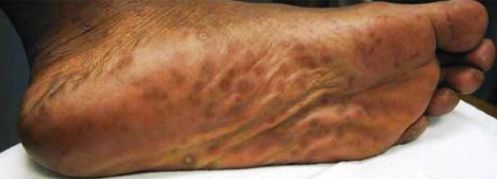Syphilis is making a comeback, including in Arkansas
Source: https://www.cdc.gov/sti-statistics/annual/slides.html
Let's get past the stigma and learn about it, to beat it!
What is it exactly and is there a treatment for it?
The short answer is that it's a sexually-transmitted disease that runs the gamut of sexual situations (genital, oral, anal, heterosexual, LGBTQ+, paid sex, consensual sex, rich, poor, 15 to 72 years old, etc.). It can also be transmitted from mother to fetus, during breastfeeding, and in very rare cases, through blood transfusion or an organ transplant.
And yes, there is treatment for it -- more info below.
Left untreated, syphilis, caused by a bacterium called Treponema pallidum, can result in serious heart and brain damage, blindness, deafness, and paralysis. A person who suspects having been exposed to it or thinks they might have some symptoms should talk with their doctor about getting tested immediately.
Symptoms to look for -- the different stages of syphilis and how they can affect a person
One reason why syphilis goes undetected is that its early symptoms mimic other infections or are easy to miss. The disease has four stages.
Primary - within three weeks of being infected
A lesion or canker (usually just one, but sometimes more than one) up to a few centimeters can appear at the spot of infection, for example, at the genital organs, oral region, or anorectal region. It isn't generally painful at this stage, but it can be associated with ganglions that can be a little sensitive. It is of course more difficult to detect lesions inside the vagina or anus than on the penis or in the mouth. The immune system usually clears the symptoms within 3 to 6 weeks, but it doesn't cure the disease because the bacteria is still in the body and escalates to secondary syphilis.
Secondary syphilis - 2 to 12 weeks after infection
A rash (blisters or red dots) can appear while the first chancre heals or a few weeks after it heals. It doesn't itch, but it can leave white scabs which dry and become flakey. The rash usually starts on the trunk of the body (chest, stomach, pelvis, back) and is also common on the palms of the hands and the soles of the feet, but they can appear everywhere on the body. They may be very faint and hard to see. An infected person can also experience at the same time: runny nose, congestion, sore throat, fever, blisters on the skin or in the mouth that look like warts, inflammation or infection of the liver, hepatitis, and/or pain in the bones. Without treatment, symptoms from this stage can come and go for months or years.

Source: https://www.cdc.gov/syphilis/hcp/images/index.html
Latent or dormant stage
During the latent stage, the bacteria is in between the cells and reproduces without being detected by the immune system, so there are no symptoms. However, the person continues to be contagious during the whole first year after infection, so the disease can be passed on to someone else without knowing it. Also, left untreated, syphilis can move on to the next stage.
3rd or tertiary stage, late syphilis
This very serious stage affects about 30% to 40% of people with untreated syphilis. At this point, the disease can give a whole variety of symptoms, including neurological and cardiovascular issues: meningitis, cranial nerve issues, fascia paralysis, anomalies in the movement of the eyes, vision and hearing problems, cognitive issues, dementia, emotional issues, paranoia, balance, continence issues, aorta proximal aneurisms, inflammation of the heart, inflammatory masses all over the body.
At any stage of the disease, syphilis can affect the brain, spinal cord, eyes, and other body parts.
About 10% of people who have syphilis and don't get treatment die from the disease. It is currently not possible to know who will fall into which category.

Image credit: Daniel Reche on Pexels
Congenital syphilis -- transmission from mother to baby
Syphilis can be transmitted from mother to fetus at any of the four stages of the disease.
Infection during pregnancy can lead to miscarriage, stillbirth, neonatal death shortly after delivery, or lifelong medical issues.
For example, if a child who has unknowingly contracted congenital syphilis survives, s/he may have bones so brittle that they break when the child begins to grow and put on weight. At present, nothing can be done to alleviate or reverse that symptom when the disease has reached that stage without treatment.
If a woman is considering getting pregnant, it is smart for her to bring up the topic of testing for syphilis with her gynecologist. The American College of Obstetricians and Gynecologists (ACOG) recommends testing pregnant women at the first prenatal care visit, during the third trimester, and at birth.
How is syphilis treated?
It is treated with penicillin and other antibiotics. As we can see from the potentially devastating effects of the disease as it progresses, getting treated as early as possible is key. Please note that a person may still be contagious for a short time after treatment, so adhering to medical advice about taking precautions to limit its spread is smart.
Together, let's limit the spread!
The evolution of syphilis parallels the discovery of penicillin (in 1940). Infections diminished after the discovery through to the 1980's, when HIV was essentially a death sentence and there was a lot of education about safe sex (i.e. using condoms), which also reduced the number of syphilis cases. The lowest rate of syphilis in the U.S. was achieved in 1999.
However, there has been an increase in infections since 2000. Today, cases in women are rising more quickly than cases in men.
Let's help spread the word -- armed with knowledge, we have the power to limit and even reduce the spread of syphilis.
References and Resources
- Johns Hopkins Bloomberg School of Public Health on the syphilis spike - https://publichealth.jhu.edu/2024/why-is-syphilis-spiking-in-the-us
- BBC on syphilis in the world - https://www.bbc.com/future/article/20230706-the-troubling-rise-in-congenital-syphilis
- Radio Canada on the return of syphilis - https://ici.radio-canada.ca/ohdio/premiere/emissions/penelope/episodes/786660/rattrapage-mardi-30-janvier-2024
- National Library of Medicine on alternative treatments for syphilis during pregnancy - https://pmc.ncbi.nlm.nih.gov/articles/PMC6750027/
- ACOG testing recommendations for pregnant women - https://www.acog.org/clinical/clinical-guidance/practice-advisory/articles/2024/04/screening-for-syphilis-in-pregnancy
- CDC (U.S. Centers for Disease Control) - slides from surveillance of sexually transmitted diseases - https://www.cdc.gov/sti-statistics/annual/slides.html
- Mayo Clinic on syphilis - https://www.mayoclinic.org/diseases-conditions/syphilis/symptoms-causes/syc-20351756
Note - The Pharmacy at Wellington's blog is written by a human :)





